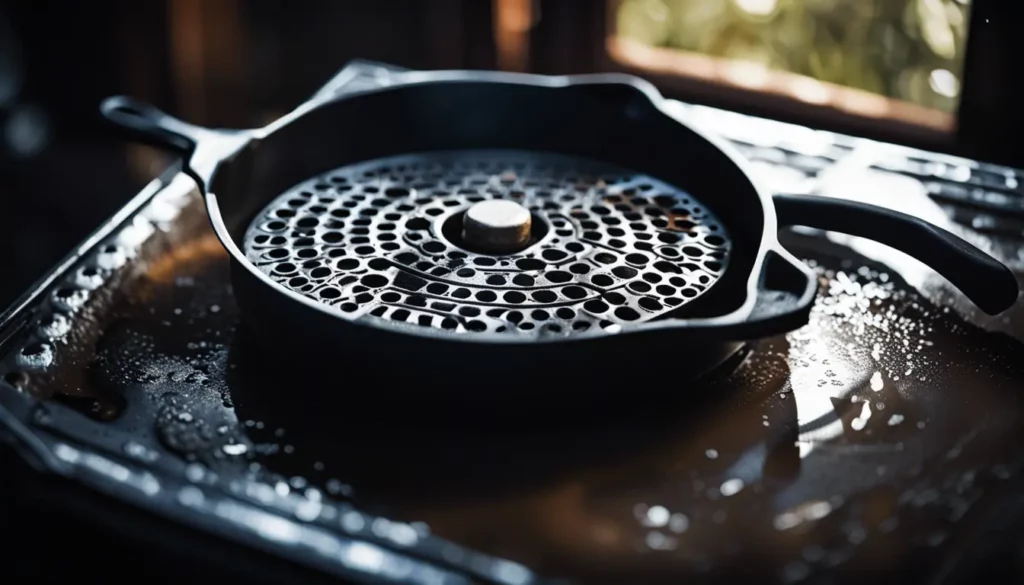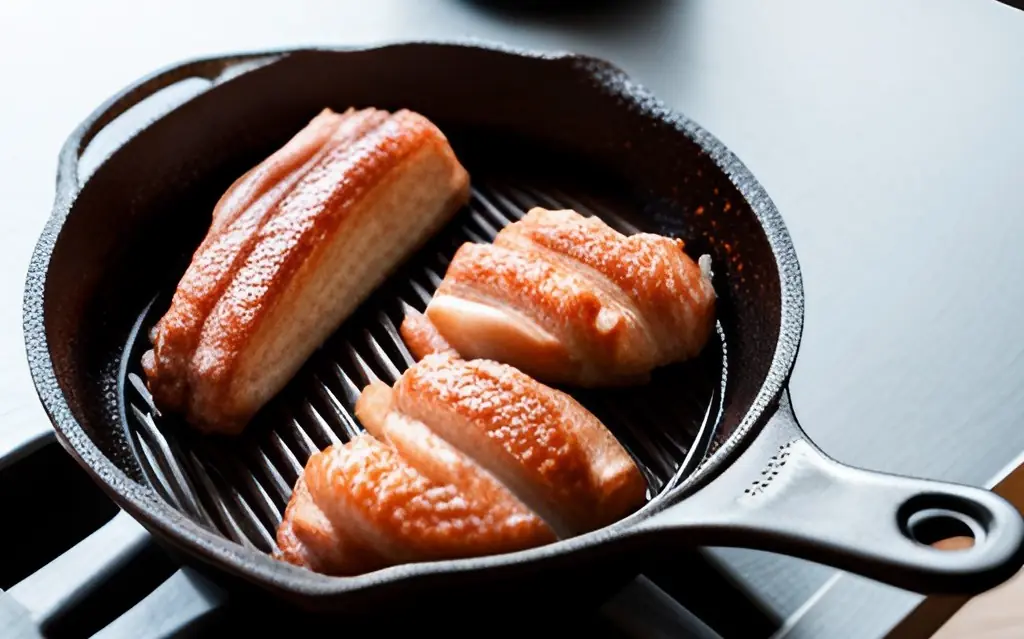Cleaning and maintaining your cast iron pan may seem like a daunting task, but with this detailed guide, you’ll find it’s easier than you think.
Here, we’ll cover the ABCs of cast iron cleaning, from washing and drying to seasoning and troubleshooting common issues.
Detailed Process of Cleaning Your Cast Iron Pan
The first task in ensuring the longevity of your cast iron pan is appropriate cleaning. Here, you’ll find an in-depth guide to cleaning your cast iron pan, from day-to-day washing to occasional deep cleaning and seasoning.
Detailed Hand-Washing:
- Begin by using lukewarm water and a small amount of mild soap to cleanse your pan gently. The warm water will help to dislodge any loose food particles while the soap helps to break down oils and grease.
- Employ a non-metal brush or sponge to scrub the pan lightly, focusing on areas with stuck-on food. Be sure to avoid any harsh detergents or dishwasher cycles as these can strip the protective, seasoned surface of the pan.
Intensive Cleaning for Stubborn Stains and Food:
- If you encounter stubborn stains or stuck-on food, a more rigorous approach is required. Coarse salt or baking soda can be used as a natural abrasive. Sprinkle your choice on the pan’s surface and scrub with a brush until the stains lift.
- For severe cases, add water or vinegar to the pan and bring it to a boil on your stovetop. The heat and vinegar will work together to dissolve hard-to-remove food.
- Once the pan is clean, rinse thoroughly to ensure all cleaning agents have been removed.
Detailed Seasoning:
- After your pan is cleaned, it’s crucial to dry it completely. Use a towel to wipe away any visible water, then place it on a low heat setting on your stove for a few minutes to evaporate any remaining moisture. This prevents rusting, a common issue with cast iron.
- Next, apply a thin layer of oil – vegetable oil, canola oil, or flaxseed oil works well. Use a paper towel to spread the oil across the entire surface of the pan, including the sides and handle.
- Remove any excess oil with a clean paper towel. The aim is to leave a thin film of oil over the pan, not a pool.
- Now, you’re ready to season the pan. Preheat your oven to around 350°F (175°C). Place the pan upside down on the middle rack, with a baking sheet or foil on the bottom rack to catch any drips. Leave the pan in the oven for about an hour.
- After an hour, turn off the oven but leave the pan inside to cool gradually. Once it’s cool, your newly seasoned cast iron pan is ready for use!
With these detailed cleaning and maintenance steps, your cast iron pan will remain in excellent condition, extending its lifespan and ensuring consistent cooking performance.

How to Dry Your Cast Iron After Cleaning: Detailed Steps
Keeping your cast iron pan dry is an essential part of its maintenance. Even a tiny amount of leftover moisture can lead to rust, damaging the pan’s surface and its non-stick properties.
Here, we’ll go through the process in detail.
Towel Drying:
Immediately after washing, use a dry, clean towel to thoroughly wipe down your cast iron pan.
Pay special attention to any crevices and corners where water might accumulate.
This is a quick and efficient method to remove most surface moisture.
Air Drying:
While towel drying is effective, it may not eliminate all the moisture.
Air drying can be a useful supplementary step. Place the pan on a dry, clean countertop, ensuring it is fully exposed to the air.
Leave it for several hours or overnight, depending on the humidity of your environment.
Stovetop Drying:
The stovetop method can be employed as a surefire way to eliminate all traces of moisture.
Place the pan on your stovetop and turn the heat to a low setting. Let it heat steadily for a few minutes.
The gentle heat will evaporate any remaining moisture that might be hidden in tiny crevices or pores of the pan’s surface. Always monitor your pan during this process to prevent overheating.
Through these detailed steps, you can ensure your cast iron pan is thoroughly dry before moving on to the next step of oiling or storing. Remember, a perfectly dried cast iron pan is the foundation for its longevity and performance in your kitchen.
Tips and Warnings
While cleaning and maintaining your cast iron pan may seem like a daunting task, it doesn’t have to be. Here are some practical tips and warnings to ensure that your pan stays in the best possible condition for years to come.
Cleaning Tips:
- Tip 1: Avoid cleaning your pan while it’s still hot. Allow it to cool fully before starting your cleaning routine. This can help prevent warping.
- Tip 2: Consider using a dedicated pan scraper to help with stuck-on food. These tools are designed specifically for cast iron and can ease the cleaning process without damaging the seasoning.
- Warning: Never put your cast iron pan in the dishwasher. This can lead to rust and ruin the seasoning.
Seasoning Tips:
- Tip 3: When applying oil for seasoning, less is more. A common mistake is using too much oil, which can result in a sticky surface. Aim for a light, even coat.
- Tip 4: The best time to season your cast iron pan is after cooking while the pan is still warm. This is because the pan’s pores will be open, allowing it to absorb oil more effectively.
- Warning: Avoid using butter, margarine, or solid fats for seasoning your pan. These can create a brittle, patchy layer rather than a smooth, hard one.
Drying Tips:
- Tip 5: When using the stovetop drying method, don’t forget to heat your pan slowly over low heat. This helps to prevent damage from sudden temperature changes.
- Tip 6: To reduce the chances of rust, always store your pan in a dry, well-ventilated location.
- Warning: Never store your pan while it’s still damp. Even the smallest amount of water can lead to rust.
In following these tips and being mindful of these warnings, you’ll be well on your way to keeping your cast iron pan in perfect shape. Remember, properly caring for your cast iron pan is key to its longevity and overall cooking performance.

Troubleshooting Common Issues in Cast Iron Cleaning
Despite your best cleaning efforts, rust and odors can still creep up on your cast iron pan.
When it comes to troubleshooting common issues with your cast iron pan, here are some handy tips and tricks to address rust and odors:
Dealing with Rust:
- Remove rust: Use steel wool or a scrub brush to gently scrub away any rust spots on the pan’s surface. Make sure to cover all affected areas.
- Rinse and dry: Thoroughly rinse the pan to remove any loose rust particles. Towel dry or use the stovetop drying method mentioned earlier to ensure the pan is completely dry.
- Re-season the pan: Once the rust is removed, it’s crucial to re-season the pan. Follow the seasoning process outlined in the previous section to restore its non-stick properties.
Eliminating Stubborn Odors:
- Baking soda and vinegar: Create a paste by mixing baking soda with a small amount of water. Apply the paste to the inside of the pan and scrub gently with a sponge or brush. Rinse thoroughly. Alternatively, you can also add a mixture of equal parts vinegar and water to the pan and simmer it for a short time to help eliminate odors.
- Proper ventilation: Ensure that your kitchen has adequate ventilation while cooking with your cast iron pan. Open windows, use exhaust fans or cook near a functioning range hood to prevent lingering smells.
Long-Term Storage Tips
If you’re putting your cast iron pan away for a while, it’s essential to ensure that it’s completely dry before storing it.
After drying, apply a light coat of oil to prevent rust during storage.
You can also use storage bags or covers to protect the pan from dust and moisture, especially if you’re storing it for an extended time.
Conclusion
Proper care of your cast iron pan is essential for ensuring its longevity and usefulness in your kitchen.
With the tips and tricks we’ve shared for cleaning and storing your pan, you’ll be able to keep it in excellent condition for years to come.
Remember to dry your pan thoroughly after cleaning, season it regularly, and store it in a dry place.
By following these care tips, you’ll enjoy a non-stick, well-seasoned cast iron pan for many meals and cooking adventures ahead.
For additional information, there are a couple of useful resources provided by cast iron manufacturers and specialists.
- Lodge Cast Iron, a renowned manufacturer, offers a wealth of knowledge on its seasoning process and ways to maintain your cast iron pan.
- Le Creuset, another well-established manufacturer, provides in-depth guidelines on cleaning and care for their cast iron products.
- Additionally, Serious Eats has an excellent, comprehensive guide on cast iron care which covers a range of tips and tricks for maintaining your pan.
Always remember to refer to the manufacturer’s guidelines for specific care instructions related to your particular cast iron pan.

I’m J.S., I created and am the content manager at DIYHouseSkills.com. I do the research and write the articles that appear on this website. I’ve learned many household skills during my life and think it’s important to at least know the basics so that you can save yourself time and money… READ FULL BIO >
- Outlet Not Working, Breaker Not Tripped | Advice
- How to Repair a Sage Coffee Machine
- Mastering the Power Drill: Tips for Effective & Safe Use
- Fixing Leaky Faucets: A Step-by-Step Guide
- Change Your Bathroom Sink Faucet The Easy Way
- Your Guide to DIY Door Handle Replacement
- Washer Won’t Drain Water – How to Troubleshoot and Fix
- Washing Machine Shakes or Bounces -Here’s How to Solve It

